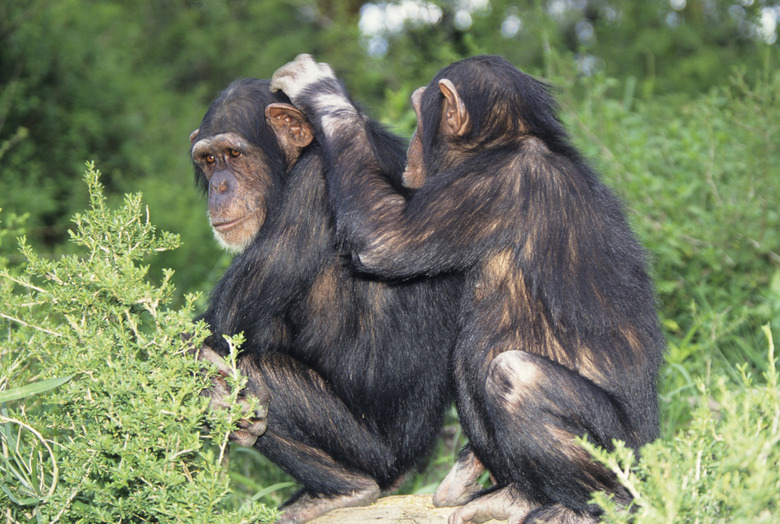Chimpanzee Mating Habits
The common chimpanzee (Pan troglodytes) and its close relative, the bonobo (Pan paniscus) are the closest relatives to Homo sapiens alive today. Like humans and other primates, chimps are social animals, forming relatively stable but fluid communities, with males, females, adults and adolescents living in close proximity over extended periods. Compared with their human counterparts, female chimps tend to be more promiscuous and go longer between births; both male and female chimps employ a greater variety of reproductive strategies than humans do.
TL;DR (Too Long; Didn't Read)
Chimpanzees become sexually mature at roughly the same ages that humans do, but unlike humans, their communities are arranged in strict male hierarchies in which all females are subservient to all males, and males compete, sometimes violently, for female sexual partners. Chimpanzees mate year-round. Males often commit violence against females or infant chimps in acts of sexual coercion.
Sexual Maturation and Fertility
Sexual Maturation and Fertility
Chimpanzees are a type of ape, which is a different kind of primate than a monkey. Chimpanzees reach puberty at roughly the same ages humans do. Male chimps become sexually mature between about 9 and 15 year old, while females experience their first menstrual periods at about the age of 10, with a menstrual cycle of about 36 days. Anogenital swelling in females signals their encroaching fertility.
In contrast to chimps, the monkey life cycle can be shorter. The female rhesus monkey, for example, reaches sexual maturity in 2.5 to 4 years, and the male rhesus monkey reaches sexual maturity in 4.5 to 7 years. In contrast to humans, female chimps remain infertile for about two to four years after their first menstrual cycle, although they copulate with aplomb during this time; this latent period is probably an adaptation to ensure safety, as females have typically migrated to a new community at around this time.
Hierarchies and Competition
Hierarchies and Competition
The males in chimpanzee communities are organized in a more-or-less linear manner from top to bottom, with an "alpha" male at the top. The alpha male is usually between the age of 20 and 26 and possesses unusual intelligence and physical prowess. Females have their own, somewhat more fluid hierarchy, and all females are subservient to all males. The males routinely patrol their communities' boundaries and will ferociously attack male interlopers from other communities they encounter there. A female considered particularly sexually appealing usually attracts a following of multiple males, and the alpha among them sometimes tries to bar others from mating with her until he can take his own turn. Adolescent females can move around among various chimpanzee communities.
Chimpanzee Mating Patterns
Chimpanzee Mating Patterns
As in humans, there is no particular time of year in which female chimpanzees are more fertile, or in estrus. That said, within a community, a higher fraction of females are in estrus when the food supply is most abundant. Both ape and monkey mating habits include the tendency to have sex for pleasure, even when reproduction is not possible because the female is not in estrus. It is a common myth that other than humans, only dolphins mate for pleasure, but in fact, orgasm has been observed in most or all primate species, as well as countless mammals and other animal species.
Female chimps will mate with a multitude of males when they are at peak fertility unless prevented from doing so by a dominant male. In fact, alpha males may even prevent other males from mating with females that he is not interested in. Chimps also manifest consortship mating, in which a male and his female sexual partner leave a community for days to weeks, as well as extra-group mating, wherein females covertly mate with males outside the community.
Sexual Coercion in Chimpanzee Mating
Sexual Coercion in Chimpanzee Mating
Male chimpanzees, like other male mammals, exhibit patterns of behavior toward females that disarm females' resistance to mating. These behaviors may include physical force and would be described in human terms as sexual assault or rape, or they may be more indirect, as when males engage in activities that partition females from other males. An example of direct sexual coercion is a male physically keeping an ovulating female to himself, which limits sperm competition. An example of indirect form of sexual coercion is a male killing infant babies that he believes are not his own. This may be an effort to spur the mother into becoming fertile again so that he can mate with her. Female chimpanzees also kill the babies of other chimp mothers.
Cite This Article
MLA
Crystal, Mike. "Chimpanzee Mating Habits" sciencing.com, https://www.sciencing.com/chimpanzee-mating-habits-6703991/. 20 July 2018.
APA
Crystal, Mike. (2018, July 20). Chimpanzee Mating Habits. sciencing.com. Retrieved from https://www.sciencing.com/chimpanzee-mating-habits-6703991/
Chicago
Crystal, Mike. Chimpanzee Mating Habits last modified March 24, 2022. https://www.sciencing.com/chimpanzee-mating-habits-6703991/
